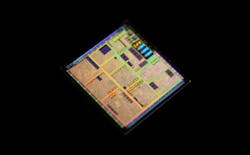Imagination Hammers Out Licensing Deal to Heal Rift With Apple
Imagination Technologies, which designs and sells the blueprints for graphics processing units (GPUs), has worked with Apple since the start of the smartphone era. Apple used Imagination's GPUs in the A-Series SoCs at the heart of the first iPhone in 2007—and every iPhone for the next decade. But Apple, looking for more self-sufficiency in semiconductors, ended the relationship in 2017 in favor of making homegrown chips.
But the companies have patched the relationship in recent months. Imagination said that it has hammered out a long-term licensing agreement that gives the Silicon Valley smartphone giant access to a wider range of Imagination's intellectual property in exchange for licensing fees. Imagination said it has replaced the current "multi-year, multi-use" licensing deal with Apple—which launched in early 2014—with its "new multi-year license agreement."
The rift between Imagination and Apple formed in April 2017. Imagination said that Apple planned to stop using Imagination's intellectual property in future generations of its A-Series and other chips slapped on the iPhone, iPad, Apple Watch, Apple TV, and its other products. Apple said it had been building a separate, independent design for graphic processing units. It planned to phase out Imagination's GPUs by early 2019, ending their licensing pact.
The company's shares collapsed by more than 50% in April after clashing with Apple over licensing. Imagination also argued that Apple would be unable to legally launch its custom graphics chips without breaching their licensing deal: "Apple has not presented any evidence to substantiate its assertion that it will no longer require Imagination's technology, without violating Imagination’s patents, intellectual property and confidential information."
The potential loss of its largest customer cast a dark cloud over Imagination, which struggled to hammer out an alternative licensing agreement in the months after it feuded with Apple. The company opened a formal complaint against Apple over the end of their licensing deal, signaling a potential legal battle. Imagination struggled to stay afloat during the dispute and was forced to sell itself to Canyon Bridge in September 2017 for around $700 million.
Apple—No.3 in the global smartphone market behind Samsung and Huawei—rolled out its first homegrown graphics processor in the iPhone X. According to Apple, the three-core GPU in the A11 pumps out 30% more performance than the six-core Imagination GPU in the A10. Based on 16-nanometers, the A10 is the most recent A-Series processor with Imagination's PowerVR GPUs. The A11 is tapping the 10-nanometer node from TSMC.
Apple slipped its second-generation graphics chip in the A12, which is manufactured on the 7-nanometer node. The quad-core GPU has 50% faster graphics performance than the A11, the company said. The A13, which was introduced late last year, also features an Apple-designed, quad-core GPU that can deliver 20% faster speeds or consumes 40% lower power compared to the A12. The A13 is using TSMC's second-generation 7-nanometer node.
Apple has been bolstering its silicon engineering efforts in recent years to stay ahead of rivals and differentiate its devices, from the iPhone and AirPods to the Apple Watch and MacBook. Apple, in its drive to control the power management integrated circuit (PMIC) at the heart of the iPhones, agreed to buy part of Dialog Semiconductor for $600 million in 2018. Intel sold its 5G smartphone modem chip assets to Apple for about $1 billion last year.
Apple's investments underscore its belief that building the hardware, software and silicon in harmony is one of its fundamental advantages over rivals. Apple has also been increasing hiring to support its development of custom chips, helping it to roll out features before rivals. Last year, Apple introduced a unique ultra-wideband chip called the U1 in the iPhone 11, which can be used to pinpoint the location of other iPhone 11 users more precisely than Bluetooth.
For Imagination, the licensing deal dispels some of the uncertainty hanging over its dispute with Apple. But the company declined to share Apple's plans for the licensing agreement—whether it will be used to add Imagination's GPUs to the iPhone or bring PowerVR to Apple's other devices. The GPU is one of the central components of Apple's A-Series SoCs, improving games and other animations on smartphones and speeding up machine learning.
Imagination last month rolled out its latest generation of GPUs—the IMG A-Series. The chips deliver more than double the performance at 60% lower power versus other solutions at the same clock speed and process. Imagination is also adding ray tracing technology to its PowerVR GPUs to boost the lighting, shadows, reflections and other visuals in smartphone gaming. Current ray tracing technology is reserved to high-end GPUs used in PCs.
Imagination said it expects chips with IMG A-Series GPUs to be introduced in 2020.
About the Author
James Morra
Senior Editor
James Morra is the senior editor for Electronic Design, covering the semiconductor industry and new technology trends, with a focus on power electronics and power management. He also reports on the business behind electrical engineering, including the electronics supply chain. He joined Electronic Design in 2015 and is based in Chicago, Illinois.

